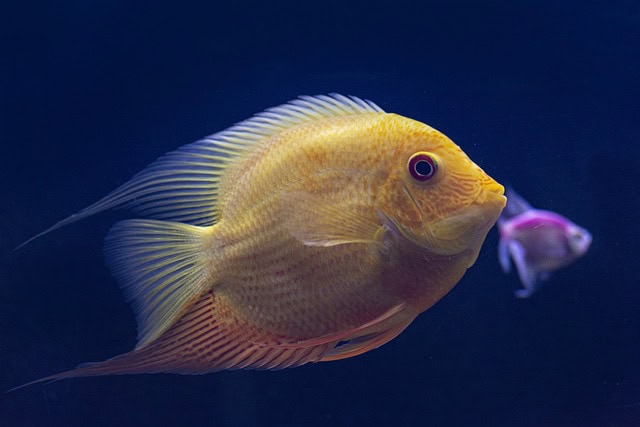Menstruation is the shedding of the uterine lining that occurs in female humans and other primates as part of the menstrual cycle.
Every month, the uterus prepares for pregnancy by building up a thick lining of blood and tissue.
If fertilization does not occur, this lining is shed through the vagina along with some blood. This monthly “period” signifies that a new reproductive cycle is beginning.
Menstruation is a uniquely mammalian process that occurs naturally in a small subset of animals. This raises the fascinating question of whether fish, which comprise over half of all vertebrate species, also undergo menstruation.
Do fish have periods like humans and other mammals? Or are their reproductive systems entirely different? This article will examine fish reproductive cycles, delving into ichthyology to uncover the answer.
While several intriguing parallels exist, fish employ unique processes that serve similar purposes to human menstruation. Understanding how fish reproduce gives us a window into the remarkable diversity of nature.
The Fish Reproductive System
Fish reproduce sexually through the pairing of male and female fish. Several anatomical differences between male and female fish enable them to perform their reproductive roles.
Female fish produce eggs in their ovaries. The eggs are large and contain nutrients to sustain the embryo as it develops. When a female fish is ready to spawn, the eggs fully develop and become ripe for fertilization.
Male fish produce sperm in their testes to fertilize the female’s eggs. Sperm are small reproductive cells released by the male to fertilize the eggs. The testes of male fish produce a steady supply of sperm throughout the breeding season to ensure fertility.
During spawning, the female releases her eggs into the water. At the same time, the male fish releases clouds of sperm called milt to fertilize the eggs.
The sperm swim through the water to reach the eggs. When a sperm penetrates an egg, fertilization occurs.
The fertilized eggs continue to develop independently without any further input from the parents. The eggs contain enough nutrients to sustain the growing embryo until hatching. This method of reproduction without live birth is standard among fish species.
Do Fish Menstruate?
No, fish do not menstruate or have “periods” like humans. Fish’s reproductive systems function quite differently from those of mammals.
Menstruation is the shedding of the uterine lining (endometrium) in mammals. It happens roughly monthly in women as part of the reproductive cycle.
This involves cyclical hormone changes that lead to the thickening and buildup of the endometrium. If pregnancy does not occur, the endometrium breaks down and is shed through the vagina as the menstrual fluid or “period.”
Fish, however, do not have a menstrual cycle or experience menstruation. Most fish species reproduce by spawning, which is the release of eggs and sperm into the water, often during specific spawning seasons.
Female fish have ovaries that produce eggs. Some fish species have an ovipositor to deposit or “lay” the eggs. The males fertilize the eggs externally by releasing milk containing the sperm. Fertilization happens outside the body in the water.
Unlike mammals, fish do not have a uterus or endometrium that builds up and breaks down if pregnancy does not occur.
Their bodies continue to produce and release eggs each spawning season without menstruating. The eggs are fertilized externally and hatch into juvenile fish.
So, while female fish produce and lay eggs, they do not menstruate or shed any tissue if the eggs are not fertilized.
The reproductive cycle and process are very different in fish compared to mammals, such as humans, who undergo monthly menstruation.
Spawning in Fish
The reproductive process in most fish species involves the female fish releasing eggs to be fertilized externally by the male. This process is known as spawning.
Spawning is triggered by complex hormonal changes that signal to the female fish’s body it is time to reproduce.
In preparation, the female’s ovaries enlarge as eggs develop. When the eggs fully mature, levels of the hormone estrogen surge, causing the female to start producing and releasing eggs from the ovary.
The male fish also undergoes hormonal changes to produce milt, a seminal fluid containing sperm. When the female releases her eggs, the male fish fertilizes them by releasing milt over the eggs.
The female may lay the fertilized eggs on vegetation, rocks, or the sea floor, depending on the species.
Some species have elaborate courtship rituals leading to spawning, while others do not. The spawning process and behaviors vary significantly between different types of fish.
Spawning is often timed seasonally and triggered by environmental cues like water temperature, day length, or rainfall.
The timing ensures that offspring hatch during optimal conditions to promote survival. After spawning, females rest before beginning the egg development process again.
Egg Laying in Different Fish Species
Fish employ various reproductive strategies when it comes to egg-laying and giving birth. Some fish species lay eggs that hatch outside the mother’s body, while others give birth to live young.
Fish that lay eggs are called oviparous. Some examples of oviparous fish include:
- Salmon – Females lay eggs in freshwater gravel nests. Males fertilize the eggs, which hatch after several weeks or months.
- Tuna – Females release up to 10 million eggs in each spawning batch. The males fertilize the eggs externally and float freely in the ocean until hatching.
- Goldfish – Females lay up to 1000 eggs on aquatic plants or substrates—the male chases away predators until the eggs hatch.
Fish that give birth to live young are called viviparous. Some viviparous fish include:
- Guppies – Females can store sperm and give birth to live young multiple times without re-mating. The gestation period is about a month.
- Seahorses – Males brood the eggs in a pouch until they hatch. Then, they give birth to fully-formed baby seahorses.
- Mollyfish – Females can store sperm for up to 6 months to continue reproducing without mating again. The gestation period is 4-6 weeks.
- Some fish, like sharks, are ovoviviparous – they lay eggs that hatch inside the mother’s body before giving birth to live young. The embryos rely on nutrients from the egg yolk.
So, fish employ reproductive techniques like external egg laying, internal gestation, and male brood pouches to continue their species. The methods vary significantly between fish species.
Menstruation in Mammals
Menstruation is the cyclical shedding of the uterine lining in certain mammals. The main mammals that menstruate are humans and some other primates, a few species of bats, and the elephant shrew.
In menstruating species, the uterus builds up a thick, blood-rich lining each month to prepare for potential pregnancy.
If fertilization does not occur, hormone levels drop, signaling the uterus to shed this lining. The bloody discharge during this shedding is during the menstruation period.
Menstruation in humans lasts, on average, 3-7 days and occurs roughly every 28 days, representing the female reproductive cycle.
Menstruation begins at puberty and continues until menopause. The length, frequency, and amount of bleeding can vary between individuals and cycles.
Compared to humans, menstruation periods in other mammals that experience it can differ significantly.
For example, chimpanzees have a reproductive cycle around 36 days long, while menses last 10-12 days. Elephant shrews have a 28-day cycle like humans but only bleed for 1-2 days.
Several evolutionary hypotheses exist for why menstruation developed in certain mammals. One theory is that frequent sloughing of the uterine lining helps prevent infections, cancerous growths, or harmful tissue buildup.
Another related idea is that menstruation allows the uterus to reset and build a new, fresh lining each cycle.
Menstruation may also signal fertility, advertise sexual receptivity, or flush out weak embryos between pregnancies.
Ultimately, scientists are still investigating the complex evolutionary benefits and biological factors in shaping mammals’ menstrual cycles over time.
Why Fish Don’t Menstruate
Fish do not menstruate because their reproductive systems and strategies differ significantly from mammals.
In mammals, the uterus builds up a thick lining of blood and tissue to support a potential pregnancy. If pregnancy does not occur, this lining is shed during menstruation. Fish do not build up a uterine lining and, therefore, have no lining to shed.
Most fish reproduce by spawning, where the female releases eggs and the male releases sperm into the water to achieve external fertilization. The fertilized eggs then continue to develop outside the body with no placental connection or need for uterine support.
Some fish species display internal fertilization and give birth live. However, even in these cases, there is no build-up of uterine lining that requires shedding. The eggs are fertilized internally, but there is no complex placenta structure.
The critical difference is that fish eggs do not implant in the uterine lining or receive complex support from the mother’s body. This is likely due to the aquatic environment and lack of amniotic egg development.
Because fish eggs do not implant, menstruation does not need to shed a uterine lining each reproductive cycle.
Fish’s reproductive strategy is focused on producing large numbers of eggs with little parental support rather than nurturing a small number of offspring, as in mammals.
Reproductive Cycles in Other Animals
Fish and mammals are not the only animal groups that have reproductive cycles. Here is a brief overview of reproduction in some other major animal classes:
Reptiles
- Most reptiles reproduce sexually, though some lizards and snakes can reproduce through parthenogenesis (asexual reproduction).
- Female reptiles produce eggs, which are often laid in nests and incubated. There is no pregnancy.
- Egg-laying depends on the seasons and environmental conditions. Some reptiles have an annual cycle, while others can reproduce multiple times yearly.
Birds
- Nearly all birds reproduce by internal fertilization and egg laying. The eggs are laid in nests and incubated by the parents.
- Most birds have a yearly reproductive cycle tied to seasonal changes. Egg laying is timed so that hatching coincides with periods of optimal resources.
Amphibians
- Amphibians like frogs and salamanders fertilize eggs externally during the breeding/mating season.
- The fertilized eggs are laid in water or damp environments. There is no internal gestation period.
- Breeding is cyclical and triggered by environmental factors like temperature and rainfall.
Insects
- Most insects reproduce sexually and rely on egg-laying, though some can reproduce asexually.
- The female lays fertilized eggs, which then hatch into nymphs or larvae. There is no pregnancy.
- Reproduction is seasonal in many insects, aimed at maximizing offspring survival. Some insects breed continuously.
So, while modes of reproduction vary widely, cyclical reproductive patterns are shared across the animal kingdom, though fish and mammals display some of the most complex cycles.
Conclusion
Fish do not menstruate or have periods like mammals. They reproduce through spawning, where the female releases eggs and the male releases sperm into the water for external fertilization. The fertilized eggs then hatch into juvenile fish that grow into adults.
Some key differences in fish reproduction compared to mammals:
- Fish do not have a uterus, which requires a lining to be shed if no pregnancy occurs. Their eggs develop and mature in the ovaries before being spawned.
- Fish eggs are fertilized externally after spawning, not internally through intercourse.
- Baby fish are completely independent after hatching, while mammalian babies require extensive parental care.
- Fish reach reproductive maturity quickly, while mammals take years to reach sexual maturity.
In summary, the menstrual cycle, which involves the shedding of a uterine lining, is unique to certain mammals and does not occur in fish species.
Fish have evolved different reproductive strategies specially adapted for an aquatic environment and external fertilization.
While fish do not menstruate, they undergo complex hormonal cycles to regulate spawning and egg production.

